
23-30 September 2015. In Greek it’s Hagia Sofia, meaning holy wisdom. In Turkish it’s Ayasofya. The Byzantine cathedral of Ayasofya is the most visited tourist attraction in Turkey. In all of Turkey. In popularity it outranks all other museums, Topkapi Palace, the ancient ruins at Ephesus, the Blue Mosque, and the extraordinary landscapes of Cappadocia and Pamukkale. I’m not sure why.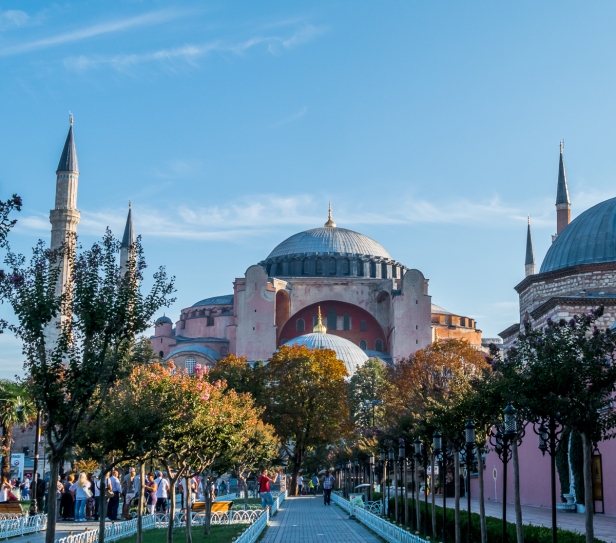
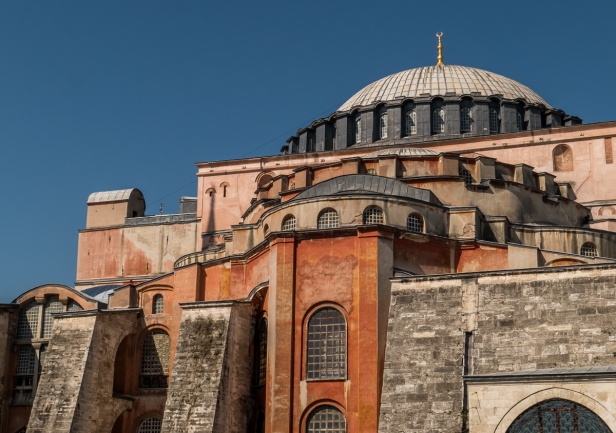
Like all major tourist attractions it’s best to arrive early. We’ve also read that it’s best to go upstairs first. So we do. It’s cavernous, and surprisingly dark, but we get a good view down into the vast space below.
We’re on the same level as the exquisite stained-glass windows. Looking around there are pockets of beauty everywhere hidden in the dingy gloom.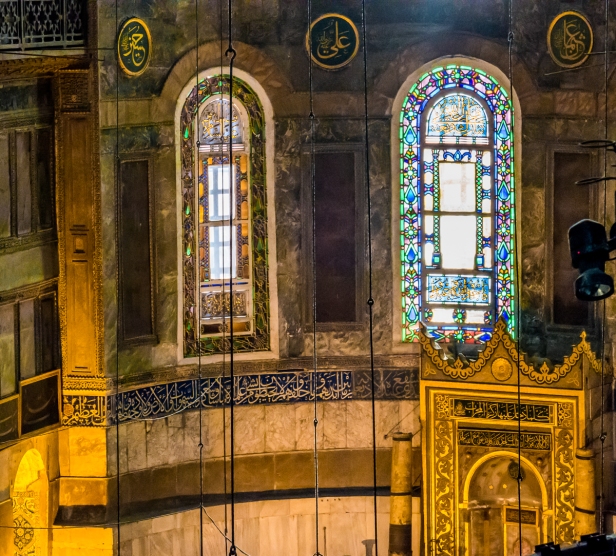

Ayasofya was built 1500 years ago as an Eastern Orthodox cathedral in what was then Christian Constantinople. Its dome is second only in size to the Pantheon in Rome and soars 55 metres (180 ft) above the marble floor. Sultan Mehmet II converted it to a mosque in 1453. In 1935 it was converted into a museum by Ataturk’s secular government.
It is a truly epic building and I wish I could have seen it like this:
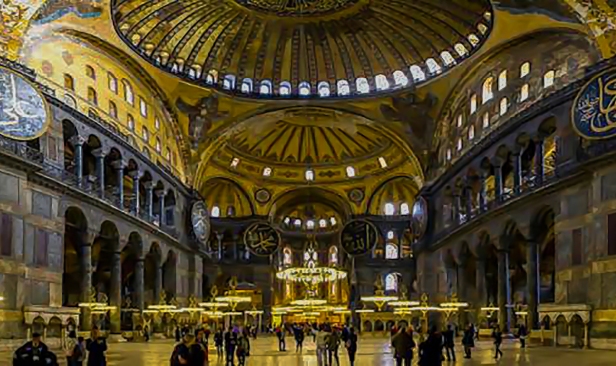
Instead literally half the interior space is filled from floor to balcony level with scaffolding covered with black cloth, which completely prevents any experience of the monumental grandeur of the space. The cloth is thick with dust. Clearly there has been no progress on restoration for a very long time.
Down on the ground floor, weaving in and out of the crowds and tour groups, I make my way to the nave, in front of the scaffolding.

And as we wander we discover delightful pockets of glowing beauty.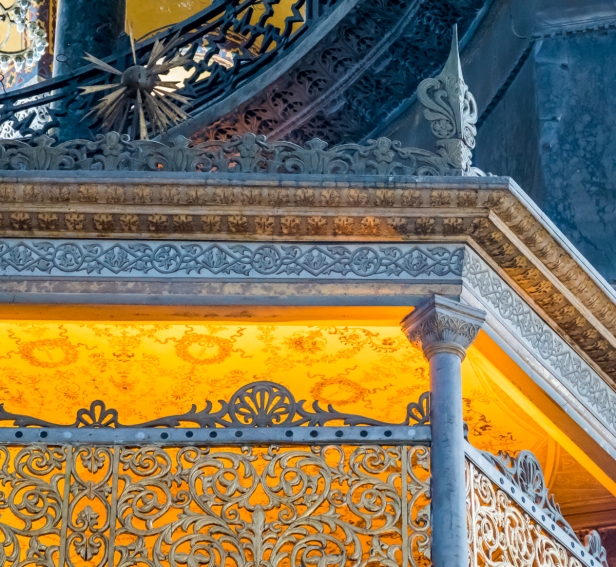
In 2015 there were 3.47 million visitors to Ayasofya. At 30 Turkish Lira each, the income from Ayasofya was over 35 million US dollars. In 2014 it was even more. Restoration is ongoing. Sporadically. According to Zeynep Ahunbay, a professor of architecture at Istanbul Technical University and known as Ayasofya’s guardian angel, “For months at a time, you don’t see anybody working”, and “one year there is a budget, the next year there is none”.
Ayasofya is a religious and political football. Muslims want it returned to a mosque, Christians want it reconsecrated as a church, and Ataturk’s secularists want it kept as a museum. The fight for funding gets kicked around by the three factions. No one faction trusts the other. There have been demonstrations in the past. Somehow a delicate balance is maintained, but it means that allocating funding for restoration is a political hot potato. The paint is peeling and flaking, there is extensive water damage, marble panels are covered in grime, windows need repairing and warped frames need to be replaced. The restoration work required is as monumental as the building. Added to that, Istanbul sits on a fault line so the building is extremely vulnerable to earthquakes. We may lose it forever before there is any more work done to restore it to its former magnificence.
What once was glorious is now a crumbling old pile, poorly maintained and thick with dust, descending into decay. It’s not wabi-sabi. It’s not even shabby chic. It’s just plain shabby, with the inescapable feeling of grimy neglect. But what do I know. We all see things differently. A close friend was in Istanbul just last week and said Ayasofya was her favourite. I suspect it could have been mine too without the scaffolding.
In the crowded Spice Market
we choose one of the eighty-five shops selling spices, Turkish delight, dried fruits and nuts, ceramics, copperware, and souvenirs.


Inside the shop we experience Turkish hospitality at its best. We are offered pomegranate tea, and apple tea, and a snack of mixed nuts and dried fruit,
while the enthusiastic salesman shows us bundled dried-flower balls.
The balls are made of dried white tea leaves with flowers hidden inside – jasmine, carnation, chrysanthemum, calendula. All this is bound together with a fine silk thread. When dropped into hot water the bundle unfolds into a delicate floating flower revealing its concealed beauty: a swirling tea dance in a goblet.
We didn’t get to drink this concoction, but we did get to try many of the salted or sweetened nuts, and a myriad of dried fruits. The salesman was very attentive and courteous. He was also disappointed when we only bought 100 grams of salted pistachios.
We also didn’t try the famed Turkish natural Viagra, mesir macunu – a concoction of forty-one spices originally blended to treat a sultan’s mother who had a serious disease. It apparently grants increased energy and a feeling of wellness.
To the Turkish, the Spice Market is known as Misir Çarsisi, meaning Egyptian Bazaar. In the 1660’s, when the market was built, goods from Egypt were taxed. It was this tax that paid for the building, hence the name. Misir Çarsisi was the last stop on the Silk Road bringing silks, spices, and other goods from China, India and Persia. It was constructed as part of Yeni Cami, known as the New Mosque. The rent from the shops paid for the upkeep of the mosque and its many charitable activities. Today the market is frequented by both locals and tourists alike.
Unlike Ayasofya, the Spice Market is bright and alive. From the jewel tones of the Turkish delight and dried fruit to the vibrant colours and rich aromas of the spices, the gorgeous ceramics and the traditional lamps, the Spice Market is a feast for the senses.
We save the Grand Bazaar until last. I don’t remember why, but we don’t go until our final day in Istanbul. We had read that it has become very touristy. It has. And it hasn’t. However many tourists there are roaming this vast complex, however many shops are dedicated to serving their needs and desires, nothing can erase the history and significance of it. Nothing can erase the feeling of other times, other lifestyles. It is steeped in stories. There is a modern overlay, but the structure itself has seen the changes of hundreds of years.
The Grand Bazaar has been an important trading centre since 1461. It is the oldest, and one of the largest, covered markets in the world with sixty streets and more than four thousand shops. As well as the shops the labyrinthine complex houses mosques, ablution fountains, two hamams, police stations, banks, and several cafés and restaurants. It is a small town, and a rabbit warren that invites you to get lost among its grand central colonnaded spaces, endless streets, and narrow hidden alleyways.

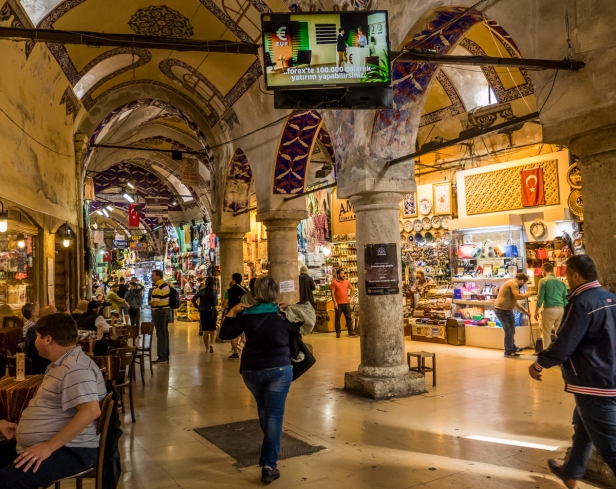
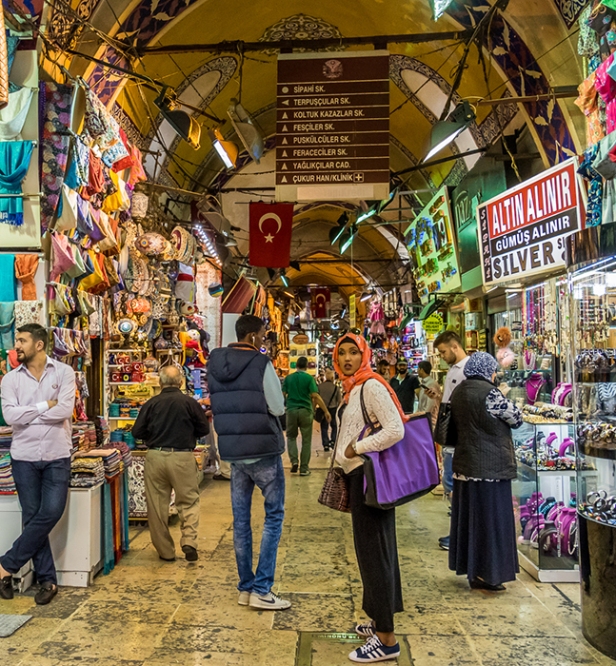
There is everything for sale from gorgeous fabrics, lush embroidered dresses, belly dancing outfits, jewellery, ceramics, spices, leather goods, antiques, copperware, silverware, and carpets.

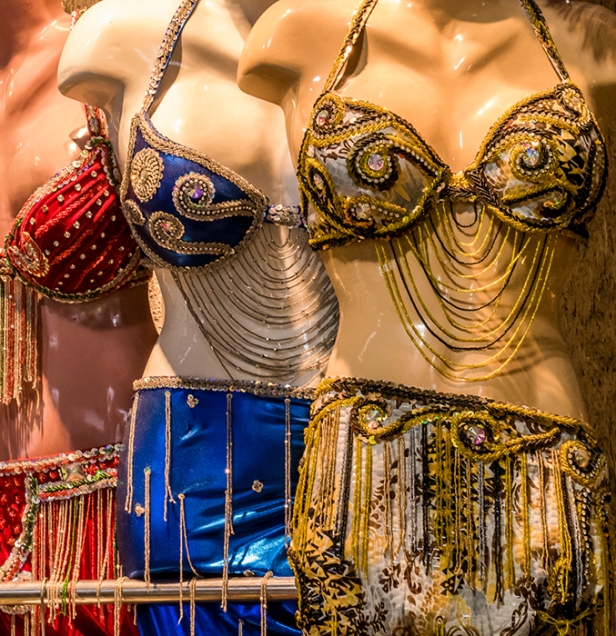
And if you look for them there are mysterious staircases to take you to hidden places like this coppersmith’s workshop adjacent to the crumbling ancient city walls.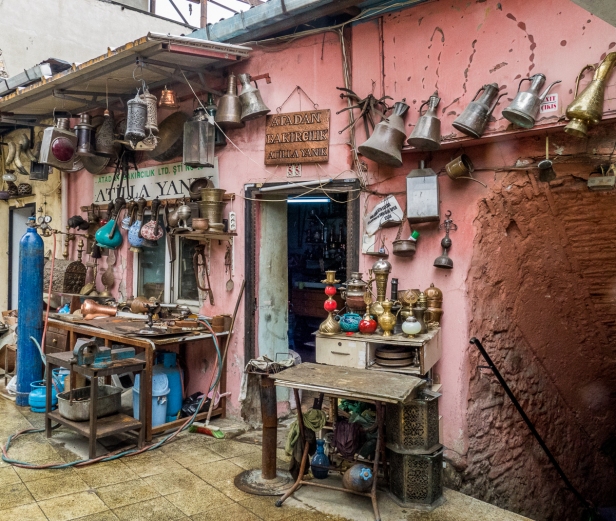

And up another set of stairs we find this leafy courtyard of offices.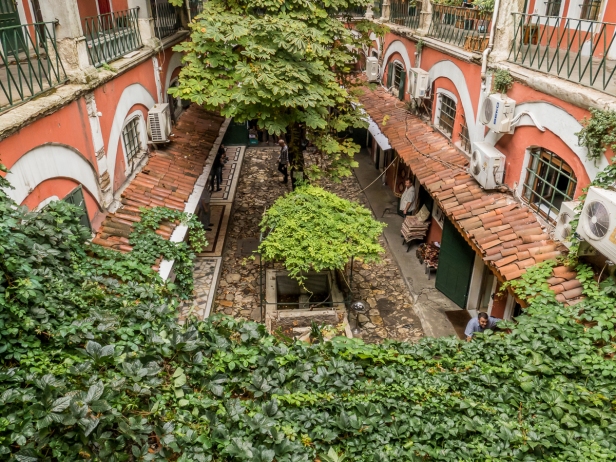
We keep trying to find a way up to the roof to see the rooftop walkway of Istanbul made famous in the movies Taken 2 and Skyfall but each time we ask we are told it is no longer allowed. It is only after we have left Istanbul that I remember I had made a note of where to see this walkway, if not walk on it. Now I don’t even have that note. Everything I have read about it tells me that you need to know a local to get to it. It always seems to involve a man with a key.
To finish off the tales of this vibrant cosmopolitan city I include some more street scenes of Istanbul:

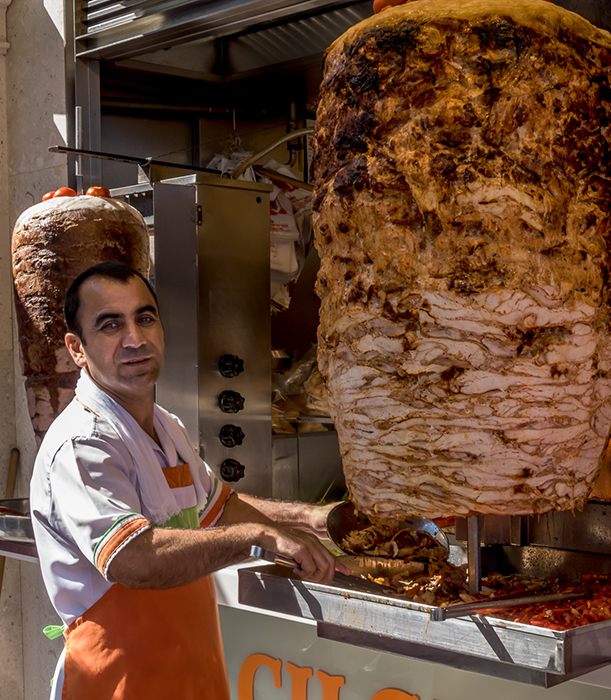


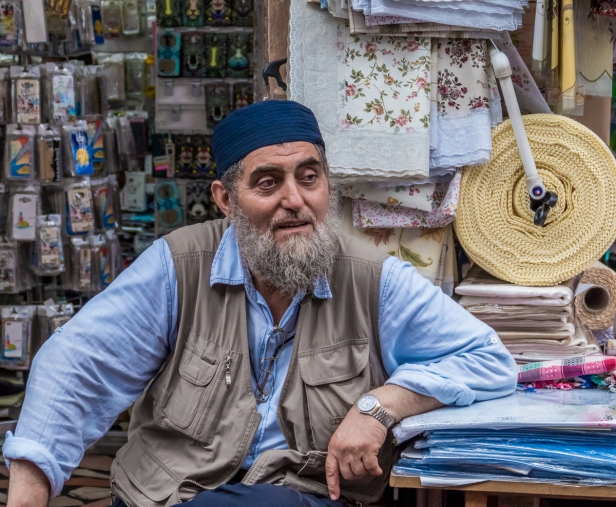

This is the final post about Turkey. We spent five weeks there. There were some disappointments: there was no water in the terraces of Pamukkale, the Sufi dancing that includes women was cancelled due to a public holiday, and Ayasofya was remarkable for its state of disrepair. But it is an extraordinary country with much to offer. Istanbul is one of the world’s great cities. The landscapes of Pamukkale and Cappadocia are unique and incomparable. The intense sunlight and azure seas of the Mediterranean resort towns make them the perfect places to explore the coast. And the country is filled from east to west with antiquities. We feel as if we only scratched the surface.
Other posts about Turkey:
Istanbul not Constantinople
A City Divided: Istanbul on the Bosphorus
The Blue Aegean and its Ancient Wonders: Turkey’s Ephesus and Bodrum
Blue Water World: Marmaris and the Dalyan River
Cruising Turkey: Fethiye and Antalya
It’s better to have no expectations: Pamukkale and Kaklik Cave
Dancing on the edge of time: Konya
Exploring On The Moon: the magical landscape of Cappadocia
Seven Things To Discover in Cappadocia
Istanbul: Topkapi Palace and other beauties
A Mosque, Some Mosaics, and a Whole Lot of Raw Meat: the streets of Istanbul
Next several posts: The Hashemite Kingdom of Jordan – Amman, Petra, the Dead Sea, and Wadi Rum.
All words and images by Alison Louise Armstrong unless otherwise noted
© Alison Louise Armstrong and Adventures in Wonderland – a pilgrimage of the heart, 2010-2016.

great pictures and post.
LikeLiked by 1 person
Thanks so much Mukul.
Alison
LikeLiked by 1 person
My pleasure
LikeLiked by 1 person
Amazing photos! What a great way to capture the city.
LikeLiked by 1 person
Thank you so much Mani. It’s a really amazing city.
Alison
LikeLike
Your blog always seems to arrive on a Sunday here in southern NSW and then I know it’s going to be a beautiful day. I totally indulge myself and just slowly absorb the beauty of your photography and your amazing descriptions of the places I’ll never get to see. Many thanks as always for bringing so much pleasure into my life.
LikeLiked by 1 person
Thanks Ros. I’m so happy you’re enjoying the blog. I imagine you sitting there in your farmhouse in Australia, reading all about Turkey while the cockatoos screech overhead.
Alison
LikeLike
alison,
i just began reading your posts. they are mesmerizing.
this week i start a two month stint in a high school world geography class. ok if i refer students to your blog?
i’m excited to read your old posts. thank you!
eddie
LikeLiked by 1 person
Thanks so much Eddie. I’m honoured that you would want to refer your students to my blog. It’s a great compliment. Please go ahead.
Alison
LikeLike
Great post, gorgeous photos as always Alison! I so want to go to Istanbul! 🙂
LikeLiked by 1 person
Thanks so much Danila. Istanbul is definitely worth visiting. Put it on the list 🙂
Alison
LikeLike
I loved the whole series of your posts about Turkey. This one about Instanbul is just shining with all its glory of that coral-orange tea, the teaflower shot is amazing, the precious robes, and portraits also Ayasofia keeps all its glory (in your pics) beyond any neglects and scaffolding. But mostly I’m grateful that you found that despite the huge tourist crowds the Grand Bazaar is still the fascinating place I imagined it to be ❤
LikeLiked by 1 person
Thanks Roberta. Istanbul is an amazing city and definitely worth visiting. There’s so much going on, and we loved the Grand Bazaar. It was rich with a sense of history, and so colourful. Same with the Spice Market. I’d never seen those tea balls before. It was really surprising to see it open up in the water.
Alison
LikeLiked by 1 person
Beautiful 🙂
LikeLiked by 1 person
I especially enjoyed your pictures in the grand bazar, but it was the candid street snaps that really grabbed me.
LikeLiked by 1 person
Thanks Tim&Joanne. We enjoyed the Grand Bazaar. And I always love taking street shots – that’s where you can get a glimpse at everyday life.
Alison
LikeLiked by 1 person
This brings back good memories of the city. When I was at the Spice Market there were so many people, even more people than the Grand Bazaar. I barely could walk as everyone was walking shoulder to shoulder. It was a fascinating place nonetheless, with all those dried spices and vegetables. I saw those tea balls, but I didn’t know when dropped into hot water they turned so beautiful, almost like a flower popping up from the bottom of the glass.
Your photos are marvelous, Alison! I really like the tone.
LikeLiked by 1 person
Thanks Bama. Yes! The Spice Market was really really crowded! In places we could hardly move. But fun, and interesting. I’d never seen the tea balls, or seen them in hot water. It was a wonderful surprise.
Alison
LikeLiked by 1 person
We visited Ayasofya in 2010 and it was magic. Yes there was some scaffolding and some decay, but to use your own words “nothing can erase the history and significance of it. Nothing can erase the feeling of other times, other lifestyles.” It was something that I had wanted to see for a long time because of the significance of its architecture – no-one knows how the huge dome was constructed. However, my favourite from Turkey was Ani – the lost city on the Armenian border. No doubt no longer safe or perhaps not even possible to visit, but awesome in its lostness and the feeling of it being a place of a thousand ghosts. There huge cathedrals were totally unprotected from the elements and magnificent frescos were fading in the weather
LikeLiked by 1 person
It wasn’t just *some* scaffolding. It was, without exaggeration, half the space from front to back and several metres high blocked off with black-cloth-covered scaffolding. I was just so slammed by the behemoth of scaffolding taking up half the space that I couldn’t get a feel for it. I could see it in bits, and appreciate the bits, but felt I never got to experience the whole. I’ve been to several unrestored Byzantine churches and loved every one. Ayasofya just seemed to reek of sad neglect for me 😦
Also Pelly (see comment) was there in 2011 and there was no scaffolding, so perhaps when you were there also, in 2010, there was not much to get in the way of experiencing the space. From the perspective of visiting the cathedral I actually don’t mind that it hasn’t been restored, but then I read about the struggles over funding and that made me more sad. I was hugely disappointed.
Ani sounds fascinating. I’d love to go to a place like that, but we made the decision to stay well away from eastern Turkey – too volatile these days.
Alison
LikeLike
It’s sound like that is a real pity about Aya Sofya. Turkey seems to be going through troubled times so I am not surprised. I am glad we visited the east when we did as we couldn’t make that trip today.
LikeLiked by 1 person
In all the photos of Ayasofya I’ve seen down the years I’ve never once heard mention of the scaffolding and funding issues. What a crying shame. Religion has much to answer for, doesn’t it Alison? Love the flower balls x
LikeLiked by 1 person
Thanks Jo. I too loved the flower balls – I’d never seen them before. Ayasofya was so sad. Helen and Pelly were there in 2010 and 2011 and didn’t see any (or much) scaffolding so I guess it went up since then. It didn’t look like anyone had worked there for a long time. And of course the scaffolding blocked off the window light from half the building so it was pretty dim in there which didn’t help.
Alison
LikeLiked by 1 person
Your posts on Turkey have been fabulous and enlightening. In spite of the scaffolding, you manage to get some great pictures of Ayasofya. I don’t think hubby would like the crowded spice market or Grand Bazaar but it looked exciting to me. Thanks for all the great photos and commentary.
LikeLike
Thanks so much Darlene. Turkey has been fun to dissect and write about. I feel sad about Ayasofya now – a bit like I got in my own way, and that I could have experienced it better if I’d been able to imagine it without the scaffolding. Now I wanna go back and have another look! Spice Market and Grand Bazaar both crowed, especially the spice Market, but fascinating also.
Alison
LikeLike
You really get a feel for the place from this post. So much beauty, so much poverty, so much history. The photos are terrific. ❤
LikeLike
Thanks Paulette. Istanbul is an incredible city, rich in history and culture. There is much beauty too. I didn’t see any crushing poverty – not the way it is in India, but I don’t doubt there are people struggling there.
Alison
LikeLike
Great post Alison! Hope they will come soon to an agreement to restart renovation on Hagia Sofia, would be sad to lose such a grand piece of “history”. I love the picture with Turkish delight!.. this is one of my favourite sweet:)
LikeLiked by 1 person
Thanks Christie. I too hope they’ll get on with restoration. it would be very sad it such a magnificent building were to be lost. And I *love* Turkish delight. We bought some of course. Yummy. I have strong memories of my mum giving it to me as a child. It was one of her favourite sweets too.
Alison
LikeLike
My imagination was captured by the ancient beauty of this religious icon when I first saw photos of the Hagia Sofia aka Ayasofya years ago and I’m saddened to learn that this treasure is not being restored and conserved. Makes you wonder whose pocket the money is going in to … ? I loved the flower balls at the Spice Market and had to wonder what the ancient mix of herbs might have been in the Turkish Natural Viagra (or if its boast were true!) Your photos had a great energy of activity and you beautifully captured so many of the sights of the spice market and Grand Bazaar that I wanted to pack a bag. Istanbul looks like a truly amazing place! Anita
LikeLiked by 1 person
Thanks Anita. Istanbul is a truly amazing place! Go pack a bag! 🙂
I’d actually never heard of Ayasofya until we started researching what to see in Turkey. Well there’s so much I’ve never heard of so that’s not surprising. But I knew enough to be expecting something truly extraordinary. Now that I’ve seen many photos of the interior without scaffolding I see that it truly is extraordinary. I’d love to go back when they’ve taken the scaffolding down, but I fear that will be a very very long time. I hope the funding money starts rolling in again. I imagine at the moment the funding is going into the govt. coffers to be distributed elsewhere. I think I read there are something like 41 ingredients in the “viagra”. Maybe the recipe is on the net. 🙂
Alison
LikeLike
I am so disappointed that Hagia Sofia is in such state… When I visited it, back in 2011 there was no scaffolding. But I was devastated by the extended catastrophe of the mosaics. Below the layers of paint there still are beautiful icons. And I agree that politics is the reason why restoration is delayed or postponed. What a shame…
LikeLiked by 1 person
Yes, obviously I too am disappointed Hagia Sofia is in such a state. I hope the restoration money is soon restored! It’s such an amazing building. Maybe one day I’ll get back there when the renovations are complete. One can dream . . . . .
Alison
LikeLiked by 1 person
I am not optimistic about the restoration money… The Turkish government is using the “Hagia Sofia issue” as a lever of diplomatic pressure (excuse my poor english…). Turkey is the country with the biggest growth of economy nowadays, there is no logical excuse for neglecting it’s number one historical tourist attraction
LikeLike
Yes I agree, there’s no excuse. Because it’s their number one tourist attraction, and because they are making so much money from it, I felt really cheated.
A.
LikeLiked by 1 person
inspiring looks, colours
& smells of the old mixing
into new continuations!
thank you for welcoming
with your compelling story.
these ancient buildings & culture
give me hope of resilience as
things change, as well as solace
recognizing impermanence 🙂
LikeLiked by 1 person
Yes, I head towards solace recognizing impermanence.
I am a buzzy bee caught in a jar when I feel cheated
or when I don’t get what I want. Bzzzzzzzzz.
Sad also that ancient wonders are neglected by
fighting factions, but joy lies in your opening sentence!
Alison xoxox
LikeLike
Wow your posts are jam packed with information, thoughts and beautiful shots. Even your comments have lots of info. Certainly a great ad for a wonderful country.
LikeLiked by 1 person
Thanks so much Louise. Istanbul is fabulous – a truly vibrant cosmopolitan city, and Turkey is definitely worth visiting.
Alison
LikeLike
We’ve really enjoyed your posts from Turkey. You have done a wonderful job with both words and photos of tantalizing us to make the trip. Thanks! Tim & Anne
LikeLiked by 1 person
Thanks Tim&Anne. It’s been a wonderful re-exploration of our travels there doing all these posts. And I learn things I never knew when I was there so I can put a post together and look vaguely like I know what I’m talking about. But the photos always let me know what to write about. Turkey’s worth visiting.
Alison
LikeLiked by 1 person
Wonderful closing piece about this enigmatic country. You beautifully captured both the energy and color of the Spice Market and Grand Bazaar, and the disappointment of Hagia Sofia. I don’t think it was quite as dusty and enshrouded with tarps when we were there in 2014, but it was a cold and cavernous old pile nonetheless. I was still entranced by the glittering icons upstairs and felt the weight of the ages and the building’s tug-of-war history somehow in that gloom. Your street portraits are awesome, as always, and a perfect way to finish Turkey up on a warm, human note!
LikeLiked by 2 people
Thanks so much Lexie. The Spice Market was touristy, and the Grand Bazaar also but not as much. Either way, they were busy and it was obvious that the locals used both places very much. Having written about Ayasofya, and read everyone’s comments, I wish I could go back now and see it with new eyes, see it the way it is instead of the way I wanted it to be. It feels like a milestone to have finally finished sharing about Turkey. 13 posts!
Alison
LikeLiked by 1 person
Beautifully told and shown. The spice market is a visual and sensual delight with its abundance of colors and smells. For those who love cooking, it’s pure magic. The saffron offered is the best in the world! I spent a ridiculous sum to take some home for making bouillabaisse and it s always a hit. Thanks for this, Alison and Don. Makes me want to return.
LikeLiked by 2 people
Thanks Helga. Well I did love the spice market even though I avoid cooking and I’m not a foodie (unless someone else cooks!) We had dinner with friends here in San Miguel a couple of nights ago and were served a seafood chowder with saffron. It was spectacular.
Alison
LikeLike
I love them all…the Blues the warmth…the details beautiful Alison! My friend from Istanbul wrote me Friday about how there are no lines ups and no tourists…I’ll find his blog link and share his insider perspectives…great post! ☺️❤️
LikeLiked by 2 people
Thanks so much Hedy. I’d like to see your friend’s post. When we were there it was pretty busy, but not impossible. Perhaps people are staying away more now because of the recent bombings. 😦
Alison
LikeLike
Remember the good old days where political types would at least work with each other, even if they ended up with something neither side was completely happy with? (Or have my memories become idealistic?)
Great pics and story, as always.
LikeLiked by 2 people
Thanks Dave. I suppose long ago there was a time people from opposing factions would at least somewhat work together. I’m sure there are examples. Now not so much it seems.
Alison
LikeLiked by 1 person
I really hate to gush here, but man…this post has EVERYTHING. The photos of the mosque are so cool. It’s interesting that a cathedral became the blueprint for later mosques! The spices! Those street scenes, especially the guy sitting in front of the painted wall with the street cleaner! I think your book is writing itself.
LikeLiked by 2 people
Oh gush! Please do! I love it. And thank you. I’m not sure that Ayasofya became the blueprint for future mosques. I don’t know what mosques built at the same time as Ayasofya looked like. I do know that the huge discs that have Arabic writing on them were added when the building was converted to a mosque, and that all the Christian frescoes and mosaics were covered over because the depiction of images is forbidden in Islam.
I, as always, had fun taking pictures of the street scenes, and people. The cat man is my favourite I think, but the street-art-with-street-sleaner is pretty cool too. Sometimes they pose just right.
As for the book – it is still but a dream.
Alison
LikeLiked by 1 person
I think WP should install a Gush button. Or a Love button. That would make things easier. And I love when I’m taking a photo and someone walks into and poses just right…but for me, it doesn’t happen that often. As for the book….how can you have a dream come true if you don’t have a dream, eh?? Your dream is a tapestry making itself.
LikeLiked by 1 person
I like that: Your dream is a tapestry making itself. One day it will be complete.
LikeLike
right…it should be a “tapestry weaving” itself…
LikeLike
I’ve really enjoyed visiting Turkey through your beautiful photos and your narratives giving the back ground history. What a pity about the scaffolding at Ayasofya Such a magnificent building should be treasured and not squabbled over. Your street scenes added a final delightful touch to linger over. I hope you are recovered after your stay in one place for a while. You must be just about ready to move on again.
LikeLiked by 2 people
Thanks pommepal. Turkey’s definitely worth visiting that’s for sure. Glad to have you along 🙂
The whole situation with Ayasofya is very sad. It’s such a special building that could be lost because of the fighting. It’s iconic, and monumental. I’d love to see it saved.
We are both much recovered thanks, and still enjoying our time in sunny Mexico. At the end of May we head back to Vancouver and will again stay put for another five months. Then we’ll hit the road again.
Alison
LikeLike
Good to take time out and refuel your batteries. We have come to a stop for the time being, so I’m enjoying travelling vicariously with my blogging friends.
LikeLiked by 1 person
Such a sad demise for Ayasofya, but your words and photos tell an important story about what happens when we get in the way of history. As always, I love your honesty in the highs and lows of what you discovered throughout Istanbul. Such a magnificent city and the Grand Bazaar is second to none. Thanks for taking us there with the scenes you captured. Enjoy your remaining time in Mexico!
LikeLiked by 2 people
Thanks Kelly. Yes, Istanbul is a magnificent city. There’s so much to it.
I wish they’d stop fighting over Ayasofya and give it the love and attention it deserves. Maybe one day. Glad you enjoyed our tour of Turkey. It was a fabulous time. Meanwhile we’re still loving sunny Mexico.
Alison
LikeLiked by 1 person
A great post, Alison. Amazing photographs and words that round the images out just so. Despite the obstacles I thought the photos you shared here were really great. The light they carried, the shapes, the nooks of beauty amidst the dingy surroundings. They spoke to me of human life in all its glory and its sadness. The bazaar was mind-blowing for me, and “rabbit warren” such a good word choice… That really set the stage for the photos. I loved the hidden levels, the copper maker’s shop, the offices. The light of day. The corridors. Did you get a map of that place or something!?
And of course it was all I could do not to put a belly-dancing outfit on layaway.
Peace
Michael
LikeLiked by 2 people
Thanks Michael. There were some beautiful pockets of loveliness in Ayasofya, but for me the scaffolding blocked any hint of the building’s grandeur, which left me really aware of the desperate need for renovation. I guess I was expecting something extraordinary, which I’m sure it was once. Really extraordinary. But now it feels just sad.

The Grand Bazaar is fabulous! You could explore there for hours. There is a map here:
but we actually didn’t have one when we were there. We just wandered, and got lost, and then got found again.
Oh go ahead. Be a devil. Buy yourself a belly dancing outfit! It will make your life complete 🙂
Love, Alison
LikeLiked by 1 person
What a shame that the Hagia Sofia hasn’t been kept up. It seems odd, but also perfectly normal, that political considerations would keep it in a state if disrepair. I guess once folks have arrived to see it, and paid their entrance fee, they don’t care if it doesn’t met expectations – they’ve gotten your money and you’ve gotten to see the inside of one of the world’s most famous churches. At least, they don’t seem to care enough about the experience inside the church to set aside religious and political differences long enough to restore it.
LikeLiked by 2 people
Yes, it’s a great shame. And what you said, about them not caring once they have your money, I think that’s what upset me the most. We came across that attitude more than in Turkey.
Alison
LikeLike
I smiled through the entire post. We spent four days in Istanbul after a cycling trip. It will forever be one of the most remarkable memories. The people, the noise, the colors, haggling in the /Grand Bazaar, the crush of the Spice Market. your photos are stunning. Truly. Thank you for this astounding tour back in my memory.
LikeLiked by 2 people
Thanks so much Sue. I’m glad it brought back good memories for you. Istanbul is a really amazing city. We loved it. Were you cycling in Turkey? We met a couple in Pamukkale who were cycling across the country on a tandem.
Alison
LikeLike
Your photos are so amazing they almost don’t seem real!! Had a laugh when saw the graffiti bunny thrown in for something a little different. 🙂
LikeLiked by 2 people
Thanks Carissa. I must admit, the whole photography part of blogging is so much fun for me, maybe even more than writing. The bunny is fun eh, especially in contrast to the people sitting below him – they seem so despondent.
Alison
LikeLiked by 1 person
Gotta admit, gave me a giggle!!
LikeLiked by 1 person
When you say you only scratched the surface, I know what you mean. There are so many places in the interior, Black Sea and far east of the country. I’d love to go back and really explore those areas. I’m sad to see this as the end of your Turkey posts, but excited to see Jordan and Egypt.
I like that Spice Market photo – that is so crowded. I never saw anything like that in Istanbul.
LikeLiked by 2 people
We would have loved to have explored the eastern part of the country but decided it was just too sketchy these days, and we saw nothing of the Black Sea area. It’s such a huge country. Still, we saw some pretty neat stuff, and I’m really glad we went.
The spice market was wild! We didn’t see crowds like that anywhere else, though all the main tourist sites were pretty busy. Not so much now apparently. I have a friend who’s in Turkey right now and apparently there are very tourists and business is way down.
Alison
LikeLike
İ love İstanbul💖 Great post👌
LikeLiked by 2 people
Thanks so much. We love Istanbul too!
Alison
LikeLiked by 1 person
What great pictures. Thank you so much
LikeLiked by 1 person
Thanks so much Vintage Cook, glad you like them.
Alison
LikeLike
This was simply brilliant! Not only was i able to walk through the bazaar of Egyptians, i could also somewhat think and relate to the feelings you must have had while doing so. Your narrative was so enrapturing! Lovely!
LikeLiked by 1 person
Thank you so much sybaritic. Both the Egyptian market and the Grand Bazaar were wonderful. Rich atmosphere and much to look at. I’m glad you were able to relate to the experience.
Alison
LikeLiked by 1 person
You have the most brilliant posts and photos – thank you!
LikeLiked by 1 person
Thank you so much! You’re welcome, and I’m glad you’re enjoying the blog.
Alison
LikeLike